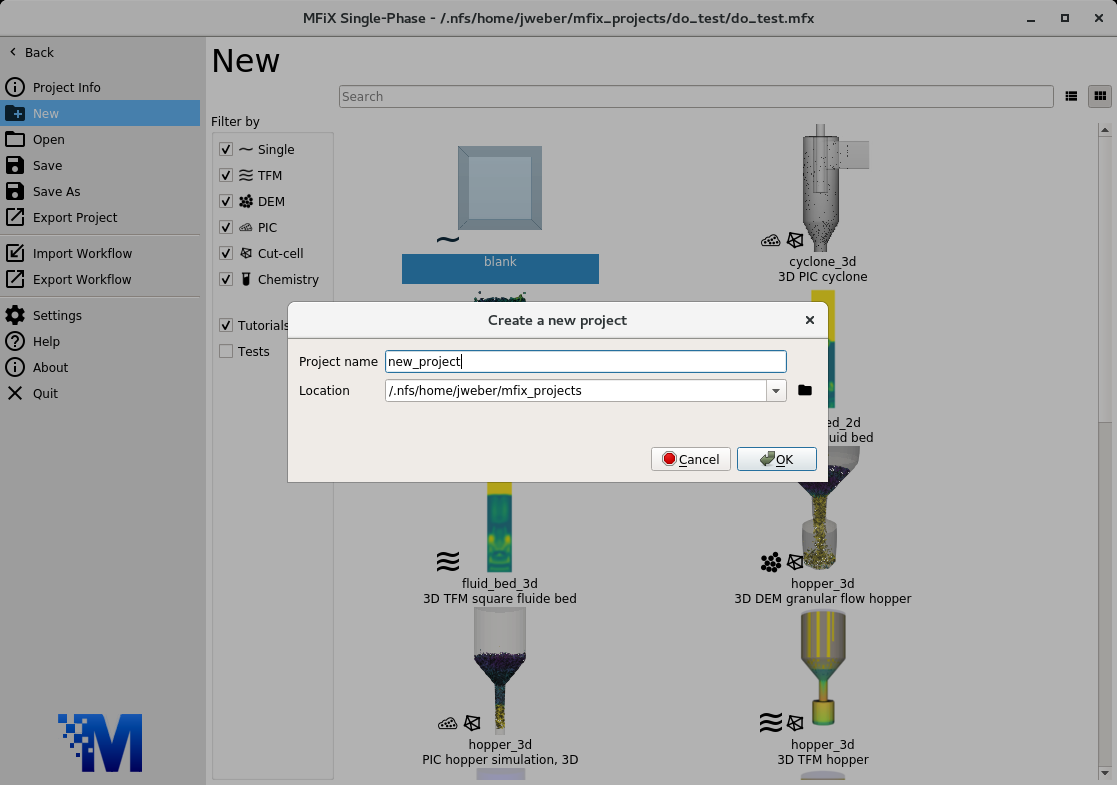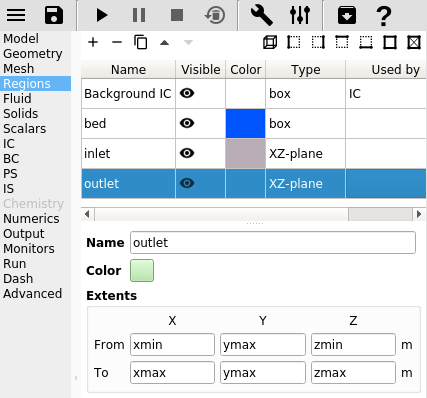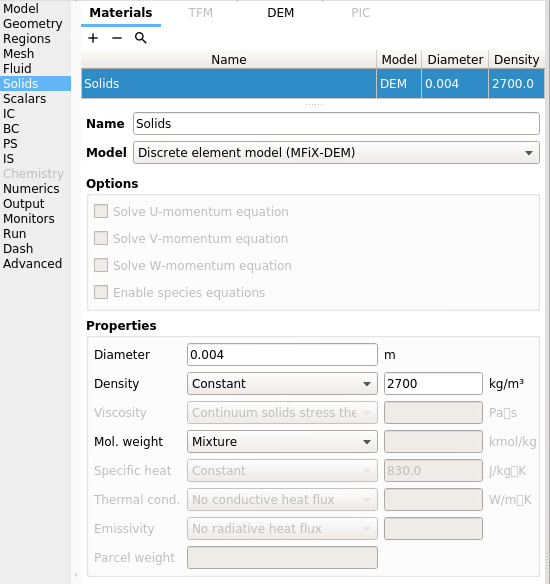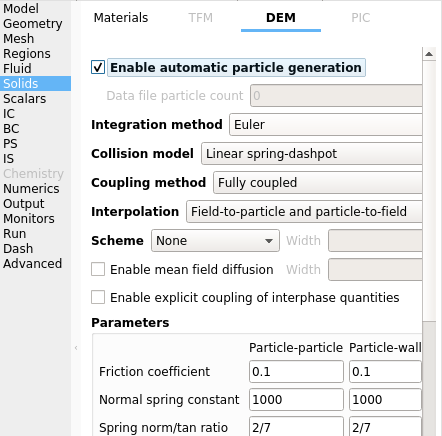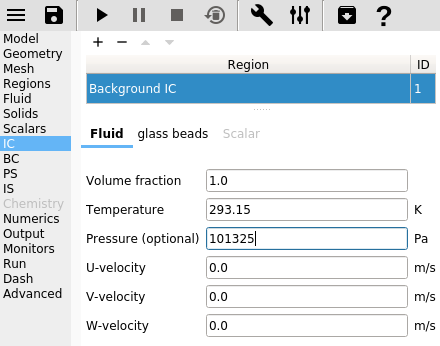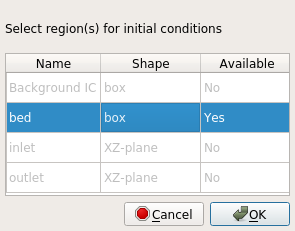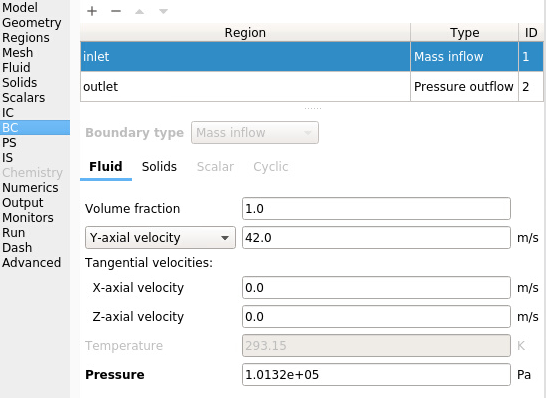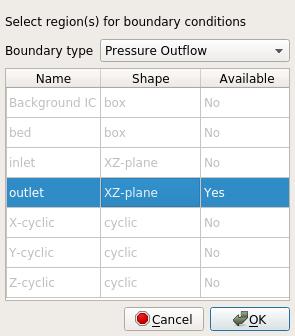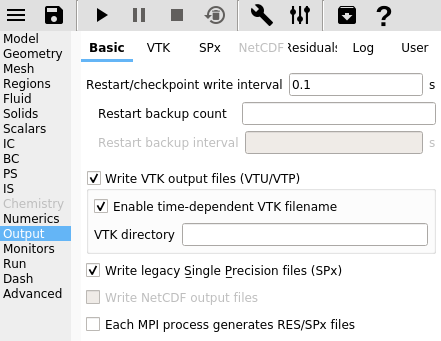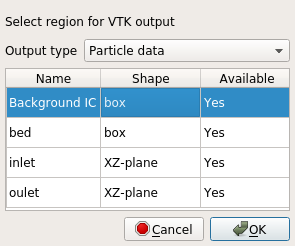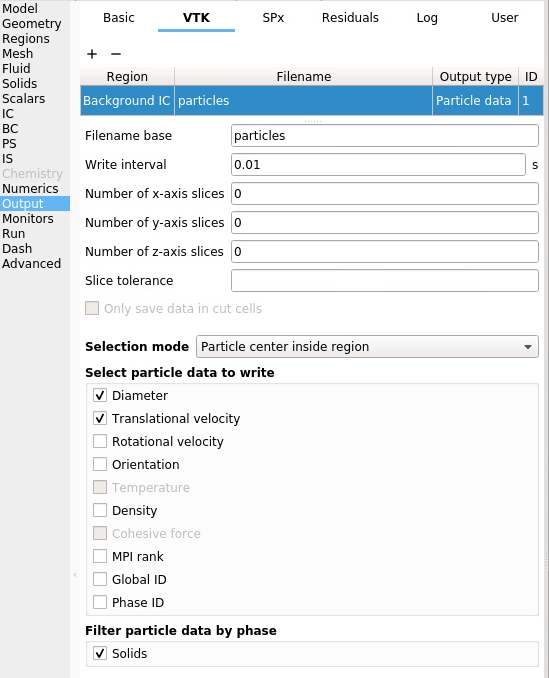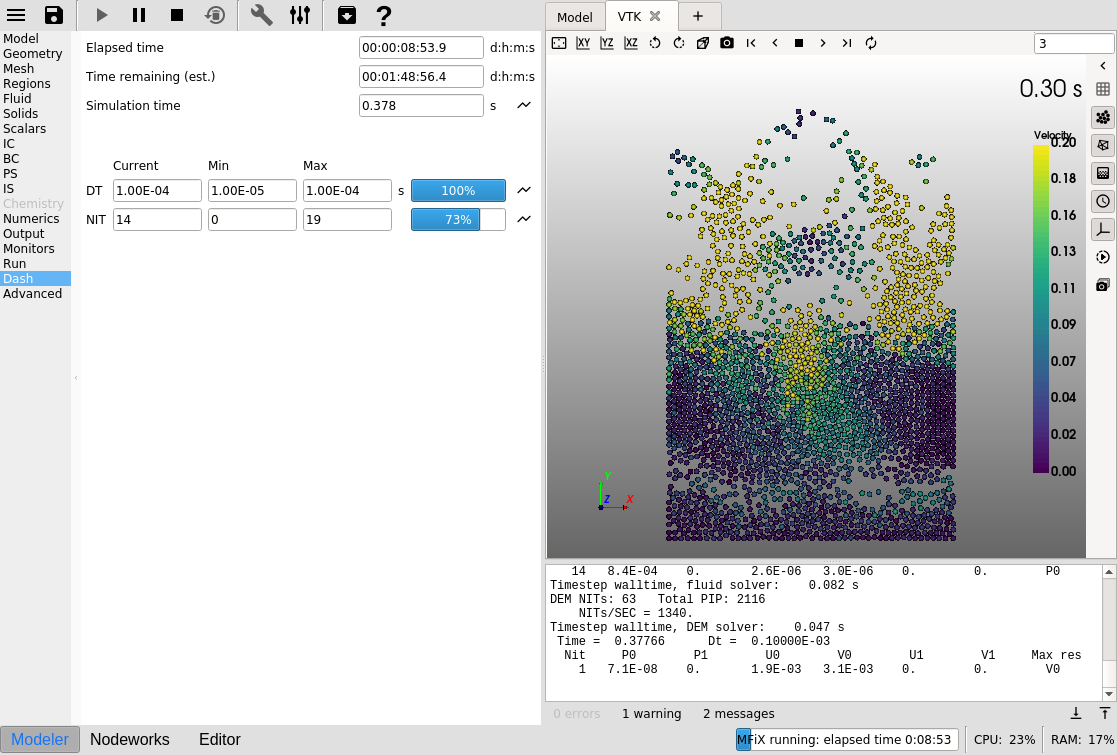3.3. Two Dimensional Fluid Bed, Discrete Element Model (DEM)¶
This tutorial shows how to create a two dimensional fluidized bed simulation using the Discrete Element Model. The model setup is:
Property |
Value |
|---|---|
geometry |
15 cm x 90 cm x 0.4 cm |
mesh |
15 x 45 x 1 |
solid diameter |
4000 microns (\(4000 \times 10^{-6}\) m) |
solid density |
2700 kg/m2 |
gas velocity |
42.0 m/s |
temperature |
298 K |
pressure |
101325 Pa |
3.3.1. Create a new project¶
On the main menu, select
New projectCreate a new project by double-clicking on “Blank” template.
Enter a project name and browse to a location for the new project.
When prompted to enable SMS workflow, answer No, we will use the standard workflow for this tutorial.
3.3.2. Select model parameters¶
On the
Modelpane, enter a descriptive text in theDescriptionfieldSelect “Discrete Element Model (MFiX-DEM)” in the
Solverdrop-down menu.
3.3.3. Enter the geometry¶
On the Geometry pane:
Enter
0.15meters for the maximum x valueEnter
0.90meters for the maximum y valueEnter
0.004meters for the maximum z value
3.3.4. Enter the mesh¶
On the Mesh pane, Background sub-pane:
Enter
15for the x cell valueEnter
45for the y cell valueEnter
1for the z cell value
Note
Since there is only one cell in the Z direction, this model is effectively a 2D simulation.
3.3.5. Create regions for initial and boundary condition specification¶
On the Regions pane:
click the
 button to create a new region that covers the entire
domain to be used for the bed initial condition.
button to create a new region that covers the entire
domain to be used for the bed initial condition.Enter a name for the region in the
Namefield (“bed”)Change the
To Yfield to be “ymax/2”Click the
 button to create a new region to be used by the gas
inlet boundary condition.
button to create a new region to be used by the gas
inlet boundary condition.Enter a name for the region in the
Namefield (“inlet”)Enter
0.07in theFrom Xfield and0.08in theTo Yfield.Click the
 button to create a new region to be used by pressure
outlet boundary condition.
button to create a new region to be used by pressure
outlet boundary condition.Enter a name for the region in the
Namefield (“outlet”)
3.3.6. Create a solid¶
On the Solids pane, Materials sub-pane:
Click the
 button to create a new solid
button to create a new solidEnter a descriptive name in the
Namefield (“solids”)Enter the particle diameter of
0.004m in theDiameterfieldEnter the particle density of
2700kg/m2 in theDensityfield
Select the
Solidspane,DEMsub-paneCheck the
Enable automatic particle generationcheckbox, so that the bed Initial Condition, defined later, will be filled with solids
3.3.7. Create Initial Conditions¶
On the Initial conditions pane:
Select the already populated “Background IC” from the region list. This will initialize the entire flow field with air.
Enter
101325Pa in thePressure (optional)field
Create a new Initial Condition by pressing the
 button
buttonSelect the bed region created previously for the bed Initial Condition (“bed” region) and click the
OKbutton.
Select the solid (named previously as “solid”) sub-pane and enter a volume fraction of
0.4in theVolume Fractionfield. This will fill the bottom half of the domain with solids.Note the estimated number of particles and inventory (around 3,200 particles or 0.3 kg). When running DEM simulations on a single core machine, it is recommended to stay below 100,000 particles to get reasonable run times.
3.3.8. Create Boundary Conditions¶
On the Boundary conditions pane:
Create a new Boundary condition by clicking the
 button
buttonOn the
Select Regiondialog, select “Mass Inflow” from theBoundary typedrop-down menuSelect the “inlet” region and click
OK
On the “Fluid” sub-pane, enter a velocity in the
Y-axial velocityfield of “42” m/s
Create another Boundary condition by clicking the
 button
buttonOn the
Select Regiondialog, select “Pressure Outflow” from theBoundary typecombo-boxSelect the “outlet” region and click
OK
Note
The default pressure is already set to 101325 Pa, no changes need to be made to the outlet boundary condition.
Note
By default, boundaries that are left undefined (here the left, right, front, and back planes) will behave as No-Slip walls.
3.3.9. Select output options¶
On the Output pane:
On the
Basicsub-pane, check theWrite VTK output files (VTU/VTP)checkbox
Select the
VTKsub-paneCreate a new output by clicking the
 button
buttonSelect “Particle Data” from the ‘Output type’ drop-down menu.
Select the “Background IC” region from the list to save all the particle data
Click
OKto create the output
Enter a base name for the
*.vtufiles in theFilename basefield (“particles”)Change the
Write intervalto0.01secondsSelect the
DiameterandTranslational Velocitycheck-boxes
3.3.10. Change run parameters¶
On the Run pane:
Change the
Stop Time stepto1.0secondsChange the
Time stepto1e-2secondsChange the
Maximum time stepto1e-2seconds
3.3.11. Run the project¶
Save project by clicking the
 button
buttonRun the project by clicking the
 button
buttonOn the
Rundialog, select the executable from the combo-boxClick the
Runbutton to actually start the simulation
3.3.12. View results¶
Results can be viewed, and plotted, while the simulation is running.
Create a new visualization tab by pressing the
 next to the Model tab
next to the Model tabSelect an item to view, such as plotting the time step (dt) or click the
3D viewbutton to view the vtk output files.On the
VTKresults tab, the visibility and representation of the*.vtkfiles can be controlled with the menu on the side.
Change frames with the
 ,
,  ,
,  , and
, and  buttons
buttonsClick the
 button to play the available vtk files.
button to play the available vtk files.Change the playback speed under the
 section on the sidebar.
section on the sidebar.
